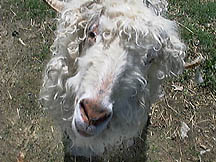Fiber Profile:
All About Mohair
Often known as "that fluffy stuff that makes me sneeze," mohair is actually one of the most versatile fibers in the world. It is shorn from the Angora goat, a charming and inquisitive creature who grazes on anything and loves a good scratch behind the ears.

This is Mo, an absolute sweetheart and one of two resident angora goats at the Blue Hill Farm Country Inn in Blue Hill, Maine.
In The Beginning
Mohair goats originated in Central Asia before making their way to Turkey during the 12th and 13th centuries. By the 14th century, fine woven mohair fabric was a popular commodity in Ankara, where it caught the eye of European traders.
There's much speculation about where the name "mohair" came from. The name is supposedly a variation on the Arabic word "mukhayar," or "choose." European traders may have associated that term with mohair cloth -- perhaps because they were always "choosing" it. One thing is sure: The fiber isn't from the hair of a "mo," whatever that animal would be.
The Great Migration
Angora goats were a highly coveted commodity in Turkey, where their exportation was forbidden until the 16th century. They were introduced to France and Spain, and in 1849, seven lucky does and two bucks were brought to the United States.
Today, the United States is one of the two major mohair producers in the world, the other being South Africa. Some 90 percent of U.S. mohair comes from Texas.
Where You'll Find It
Mohair is most often spun with a small percentage of acrylic to bind the fuzz, the result being what's called "brushed mohair." Perhaps the two most common commercial lines are Classic Elite La Gran and Berroco Mohair Classic, followed closely by Lane Borgosesia, Cleckheaton, and Ironstone.
Mohair is also added to pure wool to give it a softer feel and an attractive sheen. Brown Sheep does this in its Lamb's Pride, Prairie Silks, and Handpaint Originals lines, for example. And then you have a larger variety of yarns that are a blend of mohair, wool, and synthetic, with varying levels of quality in the results.
Did You Know?
Mohair is remarkably flame resistant and sound absorbant, so it's often used as a wall-covering for symphony halls, theaters, airports, and other large indoor public spaces.
Add your comments
